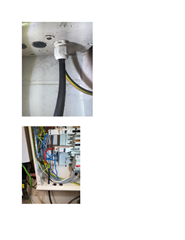Hi
We are carrying out an EICR of a commercial building, and found the external lighting columns fed in a type of Earthed concentric cable, similar to a DNO cable. This cable has an aluminium solid core with a copper stranded sheath of armouring.
It terminates in to carpark lighting columns in lighting service cut-outs, and feeds approx. 10 columns and emanates from a client commercial building and is terminated in to a standard DB.
(attached some pics)
I have seen this type of cable in lighting columns within the Road lighting network and service head supplies from network operators but never in a standard BS7671 installation.
The building where the DB is located is PME (TNCS).
Could anyone let me know the compliance Issues with this, first thing comes to mind is the shared neutral and earth ? etc
Thanks

